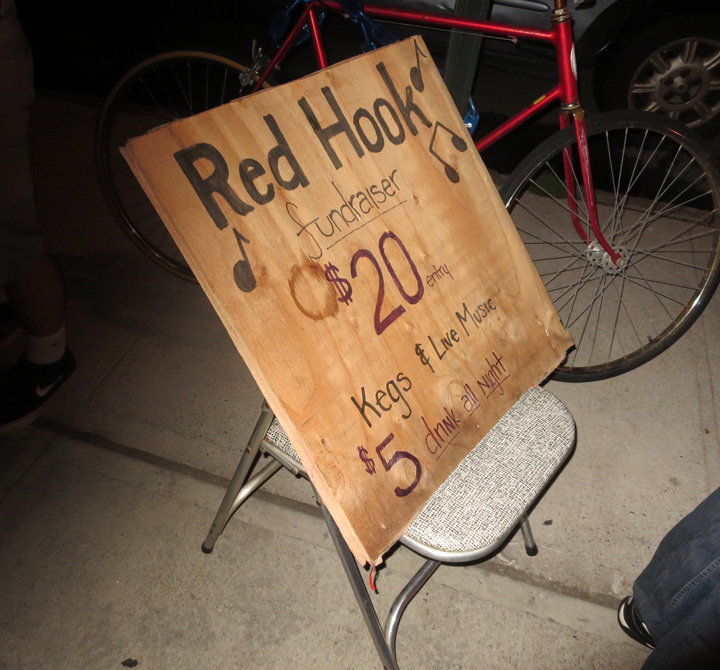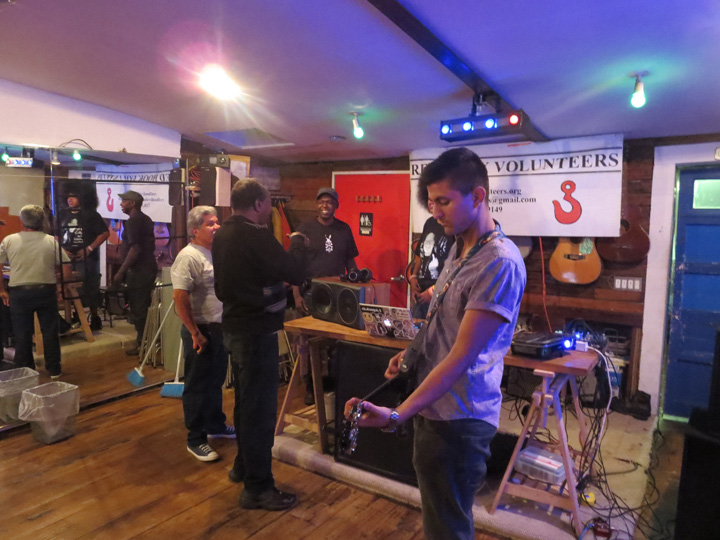The Red Hook Volunteers (RHV) have played a crucial role in the recovery efforts since Sandy. The group originated as committed individuals who came to Red Hook to help after the storm. They helped coordinate the flood of volunteers who came from all over to help.
But nearly two years after, the Volunteers are fighting to keep their doors open.
Two-year resident, Jovan Burch, has been Executive Director for the last year. He is responsible for making day-to-day decisions and coordinating the projects the volunteers are engaged in.
According to Burch, the program funding is significantly down, yet their overhead has remained steady. Utilities and rent are things that people are less willing to donate to.
RHV initially received funding from the American Red Cross and the Red Hook Coalition. Those monies have been spent, and the organization is struggling to find steady financial support.
“It’s hard to convince New Yorkers about something that’s not right in their face,” Burch said.
Many properties in Red Hook are still under metaphorical water as a result of the storm. From the streets, the neighborhood appears to be mended. But the cracks beneath the surface remain.
“People not affected by the storm have forgotten about the storm. People with their basements still gutted out have not,” Burch continued.
Fighting the same battle for several years with less and less outside help wears on people in the community, and the fight is not just a practical, ground level one. “People suffer from ‘Sandy Fatigue,’ ” Burch explained.
Mike Elders, co-founder and chairman of the board, described the bureaucratic rigors involved in applying for post-Sandy aid. “The first ten months, there was lots of support from everywhere, and lots of money around. But it was held on to too tightly.” He talked of long lines, lengthy processes, paperwork, and repetitive delays. “The people,” he says, “got tired out.”
In the immediate aftermath of Sandy, RHV had many skilled laborers donating their time and expertise. Today, however those workers are harder to come by and the jobs are not getting any easier.
While there has been a tremendous amount of progress, the initial projects included supplying food to devastated community members and “mucking out” houses of debris.

Dwindling projects
These tasks, while crucial, could be accomplished with the help of volunteers without specific skill sets. Now, most of the jobs are licensed and technical, requiring experienced attention. A year ago, they had their hands in 168 simultaneous projects framing, dry walling, carpentry, and more; today they are involved with only eight.
Grant writing is another essential job the Volunteers have been working towards – both for themselves and others – to get through the arduous application process. “A lot of nonprofits have grant writers – we didn’t. We had to write grant proposals while simultaneously helping with the recovery,” Elders said.
Without necessary grant money, RHV is unable to meet the demands for renovations the community still needs.
The Red Hook community understands the residual damage of a storm the magnitude of Sandy. All over town, people reflect about the help RHV offered immediately after the storm hit and how much work has been accomplished.
Work is still being done to offer disaster preparation and prevention, and is crucial to the survival of a neighborhood learning from its most recent disaster. The Volunteers are at the forefront of that battle.
Burch emphasizes that the focus of the nonprofit organization is to continue with recovery efforts and provide “preparedness and mitigation for future storms.” But with their present funding challenges, the success of these goals is uncertain.
Raising funds
Recently, RHV held a fundraising party to subsidize their rent payment. Their headquarters, 360 Van Brunt, is owned by local contractor, artist, and philanthropist Scott Pfaffman. He offered use of the space after Sandy hit and for the last two years been has a landlord, beneficiary, and involved board member.
Elders said, “Scott’s been a great help from the beginning. He could be renting the space to someone who could pay more faithfully than us.” Elders went on to cite several instances where the rent payment was either late or nonexistent due to delayed grant funds. In Burch’s words, “We couldn’t ask any more from him.”
But with mounting debt and tapering funding, keeping their space – which has become iconic in the community – is increasingly threatened. If the trend continues, RHV may only have a few months left. A change of that magnitude is an immense implication for the organization. “Losing our space could kill the Volunteers,” Burch somberly admitted.
While some might say that the bulk of the work has been done to remedy the damage of Sandy, the threat of another eventual super storm could have a greater impact. Without proper preparation and progress, damages throughout the neighborhood could be worse.
Five weeks after Sandy, electricity was restored. People not intimately affected by the storm assumed things had returned to normal, but that was not accurate. Elders said that while “from the streets it looked fine,” there was substantial damage including mold and ruined wiring.
“The need is everywhere. Part of rebuilding is helping those who have lived here a long time to stay here.” Some families have been in Red Hook for over 100 years, and keeping them here is a central concern of those committed to keeping the community whole.
Mold problems persist
RHV is one of only two organizations in all of Brooklyn that perform mold remediation. Two years after the Sandy, people are now starting to report instances of mold infestations. Structures with wooden foundations sat in water for weeks and soaked up so much moisture that it didn’t dry out completely.
Mold remediation – a meticulous, complicated process – involves treating soaked wood with a bleach compound that prevents mold growth. With the potential collapse of the Volunteers in Red Hook, the threat of mold – one that threatens respiratory damage and decreased property value – will persist unchecked.
RHV currently needs carpenters of any skill level. As Burch put it, “We need carpenters by the truckload.”
To donate, volunteer, request help or learn more about the organization, visit their website, www.redhookvolunteers.org, like their FaceBook page, Red Hook Volunteers, or stop by at one of their Friday night musical jams open from 6 pm-9 pm.








